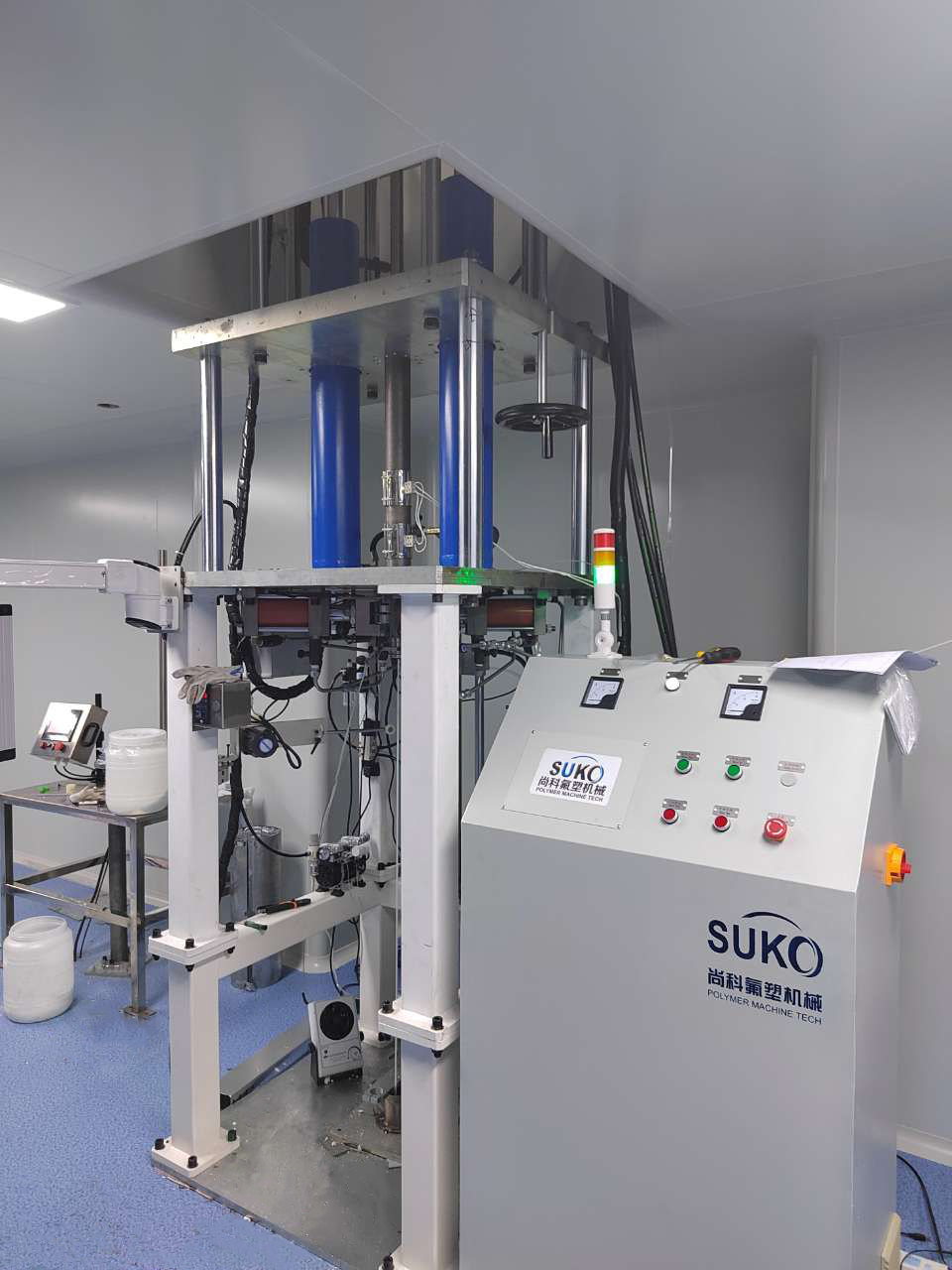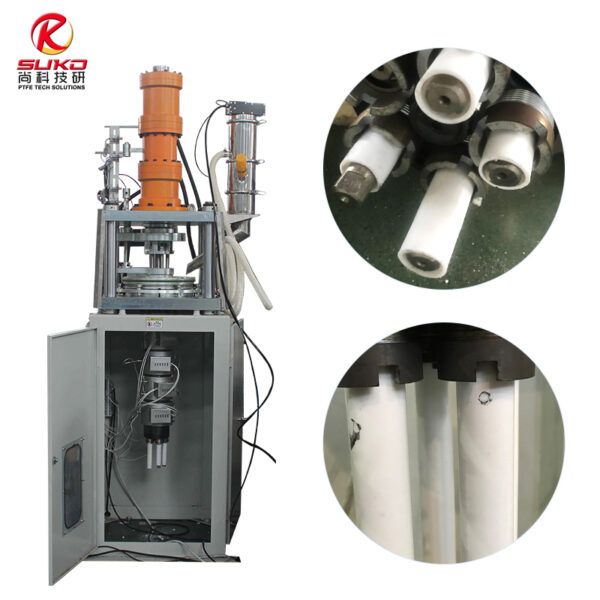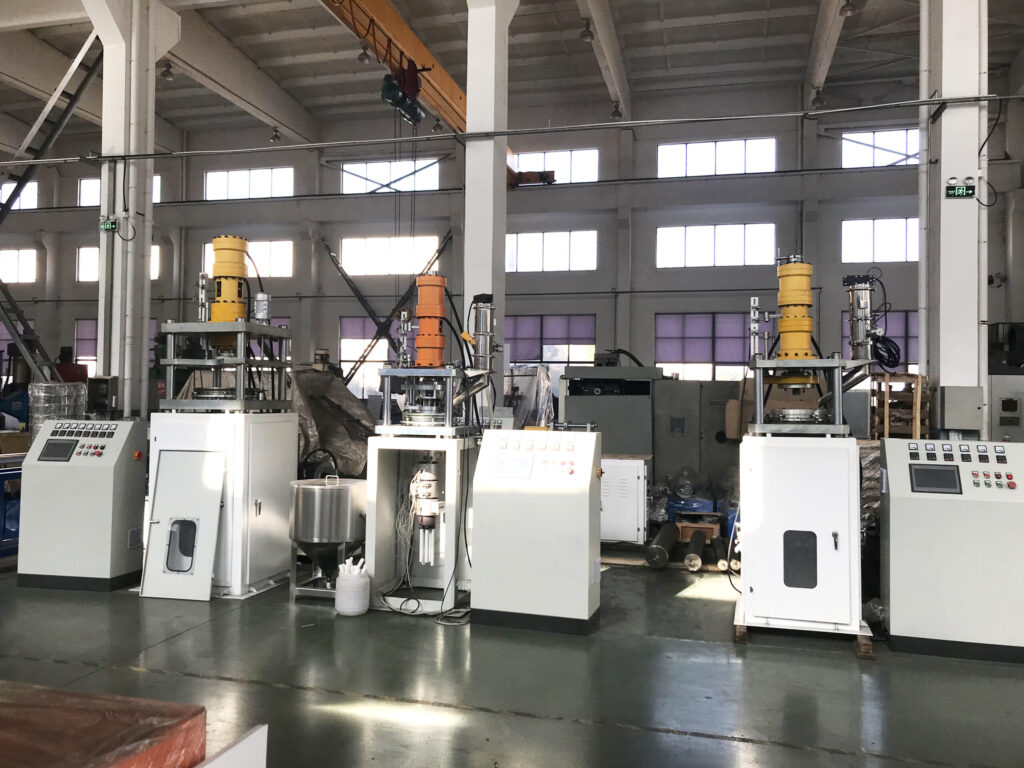In the world of advanced materials, few polymers command as much respect as Polytetrafluoroethylene (PTFE). Renowned for its extraordinary chemical inertness, vast temperature tolerance, and unparalleled low-friction surface, PTFE is the material of choice for critical applications. From life-saving medical devices to high-performance aerospace components, the demand for PTFE hoses is relentless.
However, manufacturing these components is not a simple task. The very properties that make PTFE so valuable also make it notoriously difficult to process. Achieving the micron-level precision required by today’s industries presents a significant engineering challenge. This is where the science of ram extrusion, specifically paste extrusion, becomes paramount.
Why High-Precision PTFE Tubing is Non-Negotiable in Critical Industries
Before we dive into the “how,” let’s establish the “why.” Why is an unwavering focus on high precision PTFE tubing so crucial? The answer lies in the unforgiving nature of the environments where these hoses operate. A minor flaw or a deviation of a few microns can lead to catastrophic failures.
1. Medical and Pharmaceutical:
In medical applications, precision is a matter of life and death. PTFE hoses are used in catheters, endoscopes, and fluid delivery systems.
- Biocompatibility: PTFE is non-toxic and inert, making it safe for contact with human tissue and fluids.
- Lubricity: Its low coefficient of friction allows for smooth insertion and navigation through delicate blood vessels and body cavities.
- Dimensional Stability: Consistent inner and outer diameters are essential for accurate drug delivery, proper fitment with other components (like guidewires), and preventing blockages. The success of medical PTFE hose manufacturing hinges on this precision.
According to a report by Grand View Research, the global medical tubing market size was valued at USD 9.6 billion in 2021 and is expected to expand at a compound annual growth rate (CAGR) of 6.9% from 2022 to 2030, with fluoropolymers like PTFE playing a significant role due to their superior properties.
2. Aerospace and Defense:
Aircraft and defense systems operate in extreme conditions. PTFE hoses are used for hydraulic fluid lines, wire insulation, and fuel transfer.
- Temperature Resistance: PTFE can withstand a massive temperature range, typically from -200°C to +260°C (-328°F to +500°F).
- Chemical Resistance: It is impervious to aggressive hydraulic fluids, jet fuel, and de-icing agents.
- Reliability: Precise dimensions ensure leak-proof connections and consistent flow rates, which are critical for flight control and safety systems.
3. Chemical and Industrial Processing:
In chemical plants, PTFE hoses are the lifeline for transferring highly corrosive acids, bases, and solvents.
- Universal Chemical Inertness: PTFE is one of the only materials that can safely handle nearly all industrial chemicals.
- Non-Contamination: The non-stick surface prevents residue buildup, ensuring the purity of the product being transferred.
PTFE hose dimensional accuracyis vital here to guarantee secure fittings and prevent dangerous leaks.
The Heart of Precision: A Deep Dive into the PTFE Ram Extrusion Process
Unlike common thermoplastics like PVC or Polyethylene, PTFE cannot be melt-processed. Its melt viscosity is so astronomically high that it doesn’t flow like a liquid when heated above its melting point. Instead, it forms a clear, non-flowing gel. This unique characteristic necessitates a completely different manufacturing approach: the PTFE ram extrusion process.
This process is a form of cold-forming followed by a high-temperature sintering phase. Let’s break it down step-by-step:
Step 1: Material Preparation (The Foundation of Quality)
The process begins with PTFE fine powder resin. This isn’t just any powder; it’s a special grade designed for paste extrusion. A precisely measured amount of a lubricant or extrusion aid (typically a hydrocarbon solvent like naphtha or white spirit) is added. The mixture is carefully blended under controlled temperature conditions until every PTFE particle is uniformly coated. This lubricant is critical, as it allows the particles to slide past each other during the extrusion phase.
Step 2: Preforming (Creating the Billet)
The lubricated powder is then loaded into a cylindrical chamber and compressed under high pressure to form a solid, dense billet. This preform is essentially a compressed “log” of the raw material, with trapped air removed. The quality and uniformity of this billet directly impact the final hose quality.
Step 3: Extrusion (Shaping the Hose)
The preform billet is transferred to the extruder barrel. A hydraulic or servo-electric ram then pushes this billet with immense, steady force through a die and mandrel assembly.
- The Die: Shapes the outer diameter (OD) of the hose.
- The Mandrel (or Pin): Shapes the inner diameter (ID) of the hose.
The space between the die and the mandrel defines the wall thickness. As the material is forced through this gap, it takes the shape of a continuous, green (unsintered) tube. This is the most critical stage for achieving PTFE hose dimensional accuracy. The precision of the machine, the quality of the tooling, and the stability of the ram speed are all non-negotiable.
Step 4: Sintering (The Transformation to a Solid)
The green extrudate, which is still soft and contains the lubricant, is then passed through a multi-zone sintering oven. This is a carefully controlled heating process:
- Pre-heating Zone: The lubricant is slowly evaporated. If done too quickly, it can cause cracks or voids.
- Sintering Zone: The temperature is raised to above the melting point of PTFE (around 342°C / 648°F). At this temperature, the individual PTFE particles fuse together, creating a solid, homogenous, and strong material.
- Cooling Zone: The sintered hose is then cooled under controlled conditions to lock in its molecular structure and dimensional stability.
This entire sequence, from powder to finished product, is a testament to precision engineering. Any fluctuation can compromise the final hose.
PTFE Hose Paste Extruder Machine | Ram Extrusion | High Precision
Our PTFE Hose Paste Extruder Machine is a high-precision system for producing superior PTFE hoses. This advanced ptfe ram extruder ensures consistent quality and dimensional accuracy for applications in chemical, medical, and aerospace industries. Utilizing specialized paste extrusion technology, this ptfe extrusion machine delivers smooth, defect-free hoses (0.5-70mm OD). PLC control and robust stainless steel construction guarantee reliable, continuous operation.
The Unmatched Advantages: Exploring Paste Extrusion Benefits
The method described above is technically known as paste extrusion, and it is the superior technique for producing thin-walled, high-precision tubing. The paste extrusion benefits are clear and significant when compared to other potential methods.
| Feature | Paste Extrusion (Ram) | Melt Extrusion (Screw) |
|---|---|---|
| Applicable Materials | ПТФЭ | FEP, PFA, ETFE (melt-processable fluoropolymers) |
| Wall Thickness | Excellent for very thin walls (e.g., 0.1mm) | Limited; difficult to achieve ultra-thin walls |
| Surface Finish | Exceptionally smooth inner and outer surfaces | Good, but can show signs of “melt fracture” |
| Mechanical Properties | Higher tensile strength and flexibility due to molecular alignment | Good, but generally lower than paste-extruded PTFE |
| Dimensional Tolerance | Capable of extremely tight tolerances (microns) | Good, but less precise than paste extrusion |
| Process Speed | Slower, more controlled process | Faster, continuous process |
| Primary Application | High-performance, precision tubing (medical, aerospace) | General-purpose tubing, wire coating, films |
The key takeaway is that for applications where performance and precision cannot be compromised, paste extrusion is the only viable method for PTFE. It ensures a level of structural integrity and surface perfection that other methods simply cannot replicate.
The SUKO Solution: Engineering for Ultimate Dimensional Accuracy
Achieving consistent PTFE hose dimensional accuracy is not just about the process; it’s about the machine that executes it. This is where SUKO’s expertise comes to the forefront. Our machines are designed from the ground up to master the complexities of the PTFE ram extrusion process.
Our flagship PTFE Hose Paste Extruder Machine | Ram Extrusion | High Precision is the culmination of years of research, development, and hands-on experience. It is not merely a machine; it is a complete system engineered for excellence.
As our product description highlights: “Our PTFE Hose Paste Extruder Machine is a high-precision system for producing superior PTFE hoses. This advanced ptfe ram extruder ensures consistent quality and dimensional accuracy… Utilizing specialized paste extrusion technology, this ptfe extrusion machine delivers smooth, defect-free hoses (0.5-70mm OD).”
Here’s how our technology directly addresses the critical factors for precision:
- PLC Control with Servo System: The heart of our machine is an advanced PLC (Programmable Logic Controller) coupled with a high-precision servo motor system. This provides unparalleled control over the ram’s speed and pressure. Unlike traditional hydraulic systems that can have minor fluctuations, our servo-driven ram ensures a perfectly steady, non-pulsating extrusion speed, which is the number one factor for maintaining consistent wall thickness.
- Precision Tooling (Die & Mandrel): We understand that the machine is only as good as its tooling. Our dies and mandrels are crafted from the highest-grade hardened steels, polished to a mirror finish, and manufactured to tolerances within a few microns. This guarantees the accurate shaping of the hose’s OD and ID.
- Robust, Vibration-Dampening Construction: The entire machine is built on a heavy-duty, stress-relieved frame using robust stainless steel. This minimizes vibrations during operation, preventing microscopic inconsistencies in the extrudate that could compromise dimensional accuracy.
- Integrated Temperature Control: Our systems feature multi-zone temperature control for both the extruder barrel and the sintering oven, ensuring the material is processed at the exact optimal temperature at every stage, preventing material degradation and ensuring perfect sintering.
By integrating these features, we empower our clients to produce high precision PTFE tubing that meets and exceeds the most stringent industry standards.
Real-World Applications: Where SUKO’s Technology Delivers
The proof of any technology lies in its real-world application. While respecting client confidentiality, we can share anonymized success stories that showcase the impact of our machinery.
- Success Case 1: Medical Device Innovator
A leading manufacturer of minimally invasive surgical tools needed to produce multi-lumen catheters with exceptionally thin walls and complex geometries. Their existing process suffered from inconsistent wall thickness, leading to a high rejection rate. After integrating a SUKO PTFE Hose Paste Extruder, they were able to achieve a level ofPTFE hose dimensional accuracythat reduced their scrap rate by over 80%. This directly translated into lower production costs and a faster time-to-market for their life-saving devices, solidifying their leadership inmedical PTFE hose manufacturing. - Success Case 2: Aerospace Component Supplier
A supplier for a major aerospace company was tasked with producing PTFE wire insulation for a new generation of aircraft. The specifications demanded extremely high dielectric strength and perfect concentricity (the evenness of the insulation around the wire). Our machine’s precise control over the extrusion and sintering process allowed them to produce insulation that not only met but exceeded the rigorous MIL-Spec standards, ensuring flawless signal transmission in critical avionics systems.
Take Control of Your Production Quality
The difference between a standard PTFE hose and a high-precision one is measured in microns, but the impact on performance is immeasurable. In a competitive market, you cannot afford to compromise on quality, reliability, or precision.
At SUKO, we don’t just sell machinery; we provide a pathway to manufacturing excellence. With our state-of-the-art PTFE Hose Paste Extruder Machine, you gain the power to control every variable, produce superior products, and confidently serve the most demanding industries.
Are you ready to elevate your manufacturing capabilities and leave your competition behind? The journey to perfect, high-precision PTFE hose production starts here.
- Explore the Technology: Dive deeper into the specifications of our PTFE Hose Paste Extruder Machine.
- Request a Consultation: Let our experts analyze your specific needs and recommend a tailored solution.
- Get a Quote: Discover how investing in SUKO’s technology offers an unparalleled return on investment through quality, efficiency, and reduced waste.
Contact us today or email our engineering team directly at info@ptfe-machinery.com to start the conversation. Let’s build the future of high-precision manufacturing together. Visit our website at https://ptfe-machinery.com/ to learn more about our full range of solutions.
Frequently Asked Questions (FAQ)
The key difference lies in the state of the material during processing. Paste extrusion is a cold-forming process used for non-melt-processable polymers like PTFE. It involves mixing PTFE fine powder with a lubricant, compressing it into a billet, and pushing it through a die with a ram. The part is then sintered at high temperatures. Melt extrusion is for thermoplastics like FEP and PFA. The polymer is heated until it melts, then forced through a die by a rotating screw. Paste extrusion is essential for creating high-quality, thin-walled PTFE products, while melt extrusion is not suitable for PTFE itself.
With our high-precision servo control, premium tooling, and robust machine design, our clients can consistently achieve extremely tight tolerances. For small-diameter medical tubing, tolerances on the inner and outer diameter can often be held to ±0.01mm (10 microns) or even tighter, depending on the specific hose dimensions and material grade. This level of PTFE hose dimensional accuracy is critical for high-tech applications and is a primary design goal of our machinery.
Absolutely. Our machines are specifically designed to meet the rigorous demands of medical PTFE hose manufacturing. The use of stainless steel construction, precision servo controls, and clean processing capabilities makes our systems ideal for medical-grade production environments. We help our clients achieve the ultra-smooth surfaces, biocompatibility, and precise dimensions required for catheters, endoscopes, and other critical medical devices.





